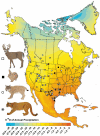Tracking cats: problems with placing feline carnivores on δO, δD isoscapes
- PMID: 21931770
- PMCID: PMC3170367
- DOI: 10.1371/journal.pone.0024601
Tracking cats: problems with placing feline carnivores on δO, δD isoscapes
Abstract
Background: Several felids are endangered and threatened by the illegal wildlife trade. Establishing geographic origin of tissues of endangered species is thus crucial for wildlife crime investigations and effective conservation strategies. As shown in other species, stable isotope analysis of hydrogen and oxygen in hair (δD(h), δ(18)O(h)) can be used as a tool for provenance determination. However, reliably predicting the spatial distribution of δD(h) and δ(18)O(h) requires confirmation from animal tissues of known origin and a detailed understanding of the isotopic routing of dietary nutrients into felid hair.
Methodology/findings: We used coupled δD(h) and δ(18)O(h) measurements from the North American bobcat (Lynx rufus) and puma (Puma concolor) with precipitation-based assignment isoscapes to test the feasibility of isotopic geo-location of felidae. Hairs of felid and rabbit museum specimens from 75 sites across the United States and Canada were analyzed. Bobcat and puma lacked a significant correlation between H/O isotopes in hair and local waters, and also exhibited an isotopic decoupling of δ(18)O(h) and δD(h). Conversely, strong δD and δ(18)O coupling was found for key prey, eastern cottontail rabbit (Sylvilagus floridanus; hair) and white-tailed deer (Odocoileus virginianus; collagen, bone phosphate).
Conclusions/significance: Puma and bobcat hairs do not adhere to expected pattern of H and O isotopic variation predicted by precipitation isoscapes for North America. Thus, using bulk hair, felids cannot be placed on δ(18)O and δD isoscapes for use in forensic investigations. The effective application of isotopes to trace the provenance of feline carnivores is likely compromised by major controls of their diet, physiology and metabolism on hair δ(18)O and δD related to body water budgets. Controlled feeding experiments, combined with single amino acid isotope analysis of diets and hair, are needed to reveal mechanisms and physiological traits explaining why felid hair does not follow isotopic patterns demonstrated in many other taxa.
Conflict of interest statement
Figures





References
-
- Baillie JEM, Hilton-Taylor C, Stuart SN. A Global Species Assessment. Gland, Switzerland and Cambridge, UK: IUCN; 2004. IUCN Red List of Threatened Species.
-
- Nowell K, Jackson P. Gland, Switzerland: International Union for Conservation of Nature and Natural Resources; 1996. Wild cats: status survey and conservation action plan.383
-
- Bowen GJ, Wassenaar LI, Hobson KA. Global application of stable hydrogen and oxygen isotopes to wildlife forensics. Oecologia. 2005;143:337–348. - PubMed
-
- Hobson KA, Wassenaar LI. Tracking animal migration with stable isotopes; In: Hobson KA, Wassenaar LI, editors. London, UK: Academic Press; 2008. 143
-
- West JB, Bowen GJ, Dawson TE, Tu KP. New York: Springer Verlag; 2009. Isoscapes: Understanding Movement, Pattern, and Process on Earth Through Isotope Mapping.487
Publication types
MeSH terms
Substances
LinkOut - more resources
Full Text Sources
Research Materials
Miscellaneous

